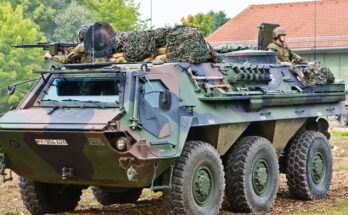By Derek Bisaccio, Military Markets Analyst, Forecast International.
By the end of May of this year, two more Project 636.3 submarines are due to be in service with the Russian Navy. On March 2, the Russian Ministry of Defense announced that the fifth diesel-electric submarine, called Veliky Novgorod, will be launched on March 18. The submarine will be floated out in Saint Petersburg on the 110th anniversary of the Russian Navy’s underwater forces.[i]
The MoD’s announcement of Veliky Novgorod’s launching was preceded by a Tass News Agency report that cited a source in the Navy as saying the launch would be on March 17. According to the same source, the Navy will launch Kolpino, the sixth and last submarine of this project, in May.[ii] Both of these submarines will join the others in the Black Sea Fleet.
The Project 636.3 submarines, built by Admiralty Shipyard, are an improved version of the initial Kilo class submarines, which entered service in the 1980s. The first of these improved submarines, Novorossiysk, was laid down in August 2010 and entered service four years later. Since then, three others – Rostov-on-Don, Stary Oskol, and Krasnodar – have entered service with the Russian Navy.
Russian media have touted the stealth features of the Improved Kilo class submarines, noting that the Rostov-on-Don, in particular, “is believed to be the quietest [submarine] in the world.”[iii] The NATO Alliance appears to view the Project 636.3 submarines similarly, dubbing them “black holes” for their stealth capabilities.
In November 2015, as Krasnodar was being launched, Adm. Viktor Chirkov, commander of the Russian Navy, stated that this type of submarine could be built for Russia’s other fleets too.[iv] Though Moscow at first did not seem interested in procuring more of the Improved Kilo class submarines after the first six, delays to the Lada class submarines (which are supposedly even stealthier) have caused Russia to change course and order six more Improved Kilo class submarines, which will eventually join the country’s Pacific Fleet.[v]
With the entrance of these submarines into service, Moscow has wasted no time in showing off their operational ability. In December 2015, Russia released footage of Rostov-on-Don taking part in Russia’s intervention in Syria. From the Mediterranean Sea, the submarine fired Kalibr cruise missiles at Islamic State positions in Raqqa,[vi] inflicting “significant damage,” according to Defense Minister Sergei Shoigu.
Russia’s Kalibr missile launches from surface ships in the Caspian Sea, which occurred several months prior to Rostov-on-Don engaging the Islamic State, were described by U.S. officials to Defense News as being “really about messaging to the world and us that this is a capability that they have and they can use it.”[vii] The use of Rostov-on-Don in the Syria campaign to bomb the Islamic State sends a similar message
Russia is intending to demonstrate to NATO its ability to deploy cruise missiles from both surface and underwater vessels to hit strategic targets in the Middle East theater, a region that had until recently been primarily dominated by NATO. Moscow is also demonstrating that it is strengthening its military appearance in the Mediterranean and Black Seas, in the face of what it sees as an expansionist NATO. The six Improved Kilo class submarines are an important component of that effort.
[i] Russian Ministry of Defense, “Veliky Novgorod newest diesel-electric submarine to be floated out in Saint Petersburg,” March 2, 2016. http://eng.mil.ru/en/news_page/country/more.htm?id=12079753@egNews
[ii] Tass News Agency, “Source: Fifth ‘Varshavyanka’ for the Black Sea Fleet to be Launched on March 17,” March 1, 2016. http://tass.ru/armiya-i-opk/2707349
[iii] RT, “Russia’s stealth ‘black hole’ submarine prepares for 4,000km trip, deep water trials,” January 8, 2015. http://www.rt.com/news/220983-russia-submarine-tests-nato/
[iv] Tass News Agency, “Navy Commander: building ‘Varshavyanka’ can be extended to other Russian fleets,” November 5, 2015. http://tass.ru/armiya-i-opk/2408635
[v] Tass News Agency, “A series of six non-nuclear submarines of Project 636 will be built for the Pacific Fleet,” January 16, 2016. http://tass.ru/armiya-i-opk/2592307
[vi] Russian Ministry of Defense, “Rostov-on-Don launched Kalibr cruise missiles at terrorist targets in Syria,” December 8, 2015. http://www.youtube.com/watch?v=fwja7sogNs4
[vii] Christopher P. Cavas, “Is Caspian Sea Fleet a Game-Changer?” Defense News, October 11, 2015. http://www.defensenews.com/story/defense/naval/ships/2015/10/11/caspian-sea-russia-navy-missiles-attack-strike-military-naval-syria-frigate-corvette-lcs-littoral-combat-ship/73671188/
For further information on this and more topics related to country-by-country military expenditures, force structures and other defense-, security-, economic- and political-related issues please see Forecast International’s International Military Markets series.
For 50 years, Forecast International intelligence reports have been the aerospace and defense industry standard for accurate research, analysis, and projections. Our experienced analysts compile, evaluate, and present accurate data for decision makers. FI's market research reports offer concise analysis of individual programs and identify market opportunities. Each report includes a program overview, detailed statistics, recent developments and a competitive analysis, culminating in production forecasts spanning 10 or 15 years. Let our market intelligence reports be a key part of reducing uncertainties and mastering your specific market and its growth potential. Find out more at www.forecastinternational.com




